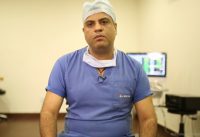Glaucoma Surgery IN INDIA
Glaucoma is a common eye condition that damages the optic nerve and necessitates treatment to prevent vision loss. Glaucoma affects around 3 million people worldwide aged 50 or more.
Glaucoma is the world’s 2nd greatest cause of blindness after cataracts. Unfortunately, glaucoma awareness is low in developing nations where up to 90% of people may be unaware of it. Though there is no cure for glaucoma, early treatment can often stop the damage and preserve your vision.
Regular eye exams are essential because early detection and treatment can slow vision loss. If you are in India or looking for successful glaucoma treatment in India, you should consult with skilled eye care doctors.
Causes of Glaucoma
Glaucoma occurs when the optic nerve in your eye is injured by high eye pressure. Your eye produces a fluid called aqueous humor, which normally drains to keep the pressure stable. However, if this drainage mechanism fails, fluid accumulates and damages the optic nerve.
The exact origin of glaucoma is unknown, but it is often linked with excessive eye pressure. Drainage can be affected by factors such as heredity, blockages, or an excess of fluid. Regular vision tests are essential for detecting it early. Though there is no cure, treatments, including those provided by glaucoma specialists in India, can help manage eye pressure and reduce the progression of damage.
Types of Glaucoma
Glaucoma is a group of eye diseases that can lead to blindness if not diagnosed and treated early. Glaucoma can be divided into multiple types, including:
Open-Angle Glaucoma:This condition develops when the drainage canal of the eyes slowly clogs, resulting in increasing intraocular pressure and optic nerve damage.
Closed-Angle Glaucoma (Angle-Closure Glaucoma):A sudden or gradual blockage of the drainage angle may result in a sharp rise in intraocular pressure.
Normal-Tension Glaucoma:Optic nerve damage can occur even when the eye pressure is normal. This type is associated with migraines, low blood pressure, and irregular heartbeats.
Congenital Glaucoma:This type of glaucoma occurs at birth as a result of underdeveloped or defective drainage channels. If not detected and treated early, it has the potential to cause blindness.
Juvenile Glaucoma:This type of glaucoma affects teenagers or young adults and, because of its early onset, presents a higher risk of blindness.
Secondary Glaucoma:This can be open or closed-angle glaucoma with an identifiable cause. Eye damage, inflammation, pharmaceutical side effects, or severe cataracts can all cause it.
Neovascular Glaucoma:This is a type of secondary angle-closure glaucoma that is associated with uncontrolled diabetes or retinal vascular occlusion.
Exfoliative Glaucoma:This is an open-angle glaucoma in which flaky material peels off the eye’s lens, causing drainage canal blockage.
Pigmentary Glaucoma:This type of glaucoma is caused by pigment granules that block fluid drainage, which tend to get stirred up during activities like jogging.
Traumatic Glaucoma:This type of condition can develop instantly or years later after an eye injury. It is usually an open-angle glaucoma caused by an injury.
Uveitic Glaucoma:This type of glaucoma is linked to uveitis (inflammation of the eye). It could be caused by autoimmune diseases or steroid use.
Normal-Pressure Glaucoma:This type of condition is similar to normal-tension glaucoma in that optic nerve damage occurs despite normal eye pressure. It is frequently associated with atherosclerosis and decreased blood supply to the optic nerve.
Signs and Symptoms
Glaucoma is a group of eye disorders that can cause optic nerve damage, resulting in vision loss and blindness. It develops gradually and may not show any signs in the early stages. However, as the disease advances, some signs and symptoms may develop. Glaucoma affects people differently, and not everyone will have the same symptoms. Some of the most common signs and symptoms of glaucoma:
- Gradual loss of peripheral vision
- Blurred or hazy vision
- Halos around lights
- Intense eye pain
- Redness in the eyes
- Nausea and vomiting
- Seeing rainbow-colored circles
Risk Factors
Glaucoma can cause optic nerve damage and visual loss and may affect people of all ages. Glaucoma risk factors include:
Advancing Age: While glaucoma can occur at any age, the risk increases with age. Individuals over the age of 40 should get periodic eye tests to detect early signs of glaucoma.
Genetic Factors: A glaucoma family history raises the probability of developing the disease. Close relatives with glaucoma can increase an individual’s risk.
Ethnicity: Certain ethnicities are associated with particular types of glaucoma. Individuals of African ancestry, for example, are more likely to develop open-angle glaucoma, whereas those of Chinese or Japanese ancestry are more likely to develop closed-angle or normal-tension glaucoma.
Vision Problems:Refractive defects like as nearsightedness (myopia) or farsightedness (hyperopia) increase the risk of glaucoma. Individuals with these vision problems should be cautious and get periodic vision tests.
Corticosteroid Usage: Using corticosteroid drugs, whether as eye drops, inhalers, or topical treatments, can raise the risk of glaucoma. This is especially important for those who use steroids to treat illnesses like uveitis, asthma, or skin problems.
Corneal Thickness:A thin central cornea has been identified as a potential glaucoma risk factor. Thinner corneas are related to greater severity of visual field loss as well as quicker progression of the disease.
Eye Trauma:Any type of eye injury, internal or external, increases the risk of developing glaucoma.Vigilance and immediate medical attention are important for those who have experienced eye trauma.
Other Health Conditions:Diabetes, high blood pressure, and poor blood circulation can all contribute to the overall risk of glaucoma. Individuals suffering from these conditions should be cautious and prioritize regular eye tests.
High Eye Pressure:High intraocular pressure is a known risk factor for glaucoma. Individuals with excessive eye pressure should be continuously observed for the progression of the disorder.
Diagnosis of Glaucoma
The diagnosis of glaucoma in India involves several extensive tests and examinations performed by top glaucoma specialists in India at the best glaucoma treatment hospitals in India. These procedures for diagnosis play an important role in detecting the type of glaucoma and establishing the best course of treatment. Some of the important diagnostic tests are:
- Tonometry for Measuring Intraocular Pressure:Tonometry is used to measure intraocular pressure, which is a significant indicator of glaucoma. Under local anesthesia, contact tonometry involves touching the cornea with a tonometer to detect intraocular pressure. Non-contact tonometry measures eye pressure using an air puff and the resistance of the eye.
- Ophthalmoscopy for Optic Nerve Examination:After pupil dilation, special lenses are used to investigate the optic nerve head in detail. The shape, color, and indications of glaucomatous structural damage of the optic nerve are examined. For optic nerve tests, imaging procedures such as stereo optic nerve pictures, scanning laser polarimetry, confocal scanning laser ophthalmoscopy, and optical coherence tomography (OCT) may be used.
- Perimetry for Visual Field Monitoring:Automatic perimetry is used to evaluate peripheral and central visual fields. Patients respond to light spots in their peripheral vision, which helps in the detection of glaucomatous changes. Perimetry is necessary for monitoring any gradual loss of vision field, which is a common symptom of glaucoma.
- Gonioscopy for Determining Glaucoma Type:Gonioscopy, which is done under local anaesthetic, determines the drainage angle of the eye. This non-invasive method differentiates between angle-closure and open-angle glaucoma.
- Pachymetry for Determining Corneal Thickness:Pachymetry measures corneal thickness, which influences eye pressure readings. Thin corneas are a risk factor for glaucoma, and this painless test may help with the best course of treatment.
Treatment Options in India
Top glaucoma specialists in India provide complete treatment options for glaucoma in India. The cost of glaucoma treatment in India varies based on the type of intervention needed, the severity of the problem, and the hospital that is chosen.
Glaucoma damage cannot be reversed through treatment. The primary goal is to keep vision from worsening further. India is home to cutting-edge eye care facilities outfitted with cutting-edge equipment and knowledgeable doctors. In India, glaucoma is treated using a variety of approaches, and early treatment is essential for preventing further loss of vision. Treatment options for glaucoma include:
- Medications:Prescription eye drops are widely utilized to reduce pressure in the eyes and protect the optic nerve. These eye drops could be prostaglandins, beta-blockers, alpha-adrenergic agonists, carbonic anhydrase inhibitors, or rho kinase inhibitors. Each class has a distinctive way of action as well as possible side effects. Medications often serve as the first line of protection, and their efficacy is checked through periodic tests.
- Laser Treatment:Laser treatment is used to help fluid drain from the eye, reducing the pressure inside the eye. This is an easy procedure that can be done in the doctor’s office. It is a useful choice when drugs alone are insufficient to reduce eye pressure.
- Surgery:Surgery may be recommended if medicines and laser treatment are insufficient for the treatment. Several procedures are available to help in the discharge of fluid from the eye. When different treatments fail to successfully manage glaucoma, surgical options are considered. Surgery is decided based on the individual’s health and response to previous treatments.
Different Types of Glaucoma Surgery
India is a global center for cutting-edge glaucoma treatment, with top-tier doctors and world-class hospitals equipped with cutting-edge technology. Top glaucoma specialists in India play an important role in providing specific treatment plans. The best glaucoma treatment hospitals in India provide the highest level of care. Surgical procedures play an important role in the treatment of glaucoma, especially when conservative treatments such as eye medicines and laser therapy are ineffective.In India, glaucoma treatment options include surgeries such as:
Trabeculectomy:Trabeculectomy is a filtration process in which a small incision in the sclera (white area of the eye) is made to allow the aqueous humor (fluid within the eye) to drain out, minimizing intraocular pressure. This surgery tries to build a new aqueous humor drainage channel, reducing IOP and preventing extra optic nerve damage.
Glaucoma Drainage Implants (GDI):A small device, such as a tube or shunt, is implanted in the eye to allow aqueous humor to drain from the eye into an external reservoir, effectively reducing intraocular pressure. When trabeculectomy is not possible or has failed, GDIs are used to provide an alternate drainage pathway for excess fluid.
Laser Trabeculoplasty:Laser radiation is given to the trabecular meshwork, which improves aqueous humor outflow and lowers intraocular pressure. When compared to traditional surgery, laser trabeculoplasty is a less invasive approach that is utilized as an initial treatment or in combination with other surgical procedures.
Cyclophotocoagulation:The ciliary body, which produces aqueous humor, is treated with laser energy. This reduces fluid production, which lowers intraocular pressure. Cyclophotocoagulation is normally reserved for advanced cases of glaucoma when other treatments have failed.
Minimally Invasive Glaucoma Surgery (MIGS):MIGS includes a group of minimally invasive approaches, including trabecular micro-bypass stents and microcatheter-based procedures, that aim to increase aqueous humor outflow with minimal damage to the anatomy of the eye. MIGS procedures are intended to have a lower level of risk and a faster recovery time than standard surgeries, making them appropriate for mild to moderate glaucoma cases.
Selective Laser Trabeculoplasty (SLT):SLT uses laser radiation to target cells in the trabecular meshwork, allowing for better drainage. SLT is a repeatable and less intrusive procedure that is used to treat open-angle glaucoma and as an alternative to medications.
Combined Glaucoma-Cataract Surgery:Best glaucoma doctors in India conduct combination cataract – glaucoma surgery in India at best glaucoma hospitals in India for people who have both cataract and glaucoma.
Glaucoma Surgery in Infants in India
Glaucoma surgery in infants in India involves specialized procedures designed to treat children’s glaucoma, a disorder characterized by high intraocular pressure that can lead to vision loss. Glaucoma care in infants is particularly difficult due to the unique considerations of their developing eyes. Surgical options for pediatric glaucoma include:
Trabeculotomy:Trabeculotomy is a common surgical option for pediatric glaucoma in India. This procedure involves cutting the trabecular meshwork to enhance aqueous humor outflow. Traditional surgical procedures or newer minimally invasive procedures can be used to conduct trabeculotomy.
Glaucoma Drainage Implants (GDI):GDIs, such as Ahmed valve implants, are becoming more common in pediatric glaucoma surgery in India. These devices provide an alternate drainage channel for aqueous humor, which is especially useful when standard surgery is ineffective.
Cost in India
The glaucoma treatment cost in India varies depending on the surgical procedure, the hospital where it is done, and the experience of the doctors involved. Treatment cost in India includes:
Glaucoma Laser Treatment Cost in India:
- Laser Peripheral Iridotomy (One Eye): 150 USD
- Laser Trabeculoplasty (One Eye): 1200 USD
- Laser Cyclophotocoagulation (One Eye): 250 USD
Glaucoma Incisional Surgery (Laser Treatments) Cost in India:
- Aqueous Shunt or Drainage Implant Surgery (One Eye): 1500 USD
- Incisional Trabeculectomy Surgery (One Eye): 1000-1200 USD
- Minimally Invasive Incisional Glaucoma Surgery (MIGS) for One Eye: 1200 – 1500 USD
- Congenital Glaucoma Surgery for Infants (One Eye): 1000 – 1200 USD
- Combined Glaucoma + Cataract Surgery (One Eye, depending on the quality and make of IOL): 1500 – 2400 USD
Best Hospitals for Glaucoma Treatment in India
India is home to several world-class glaucoma treatment hospitals. These best hospitals for glaucoma treatment in India have cutting-edge technology and a team of the best glaucoma doctors in India. Patients looking for the top glaucoma hospital in India can benefit from advanced diagnostic services, cutting-edge laser treatments, and professional surgical procedures. These hospitals are popular locations for individuals looking for top glaucoma doctors and successful treatment outcomes due to their commitment to quality eye care.
- Centre of Sight, New Delhi
- Eye Q Hospital, Gurgaon
- Fortis Memorial Research Institute, Gurgaon
- Indraprastha Apollo Hospital, New Delhi
- Kokilaben Dhirubhai Ambani Hospital, Mumbai
- Bharti Eye Hospital, New Delhi
- Medanta – The Medicity, Gurgaon
- Artemis Hospital, Gurgaon
- BLK Super Speciality Hospital, New Delhi
Best Glaucoma Treatment Doctors in India
Some of the top glaucoma specialists work in India, enhancing the field of glaucoma treatment in India. These top glaucoma specialists in India are well-known for their ability to provide the best glaucoma treatment in India. These top glaucoma doctors in India are known for their significant knowledge and use of cutting-edge diagnostic techniques and innovative treatment strategies. Patients seeking the best glaucoma treatment can benefit from the knowledge of these renowned doctors, who are committed to providing tailored and effective treatment plans.
- Pratik Ranjan Sen – Apollo Hospitals, Chennai
- P Vijay Anand Reddy – Centre for Sight Eye Hospital,Hyderabad
- Vandana Khullar – Pushpawati Singhania Research Institute, New Delhi
- Dheeraj Gupta – Marengo Asia Hospitals, Gurgaon
- Dharitri Samantaray – Bharti Eye Hospital, New Delhi
- Jalpa Vashi – Manipal Hospitals Life’s On, Whitefield, Bangalore
- Hema Rawal – Centre for Sight Eye Hospital, Gurgaon
- Deependra V Singh – Apollo Spectra Sheetla Hospital & Eye Institute Pvt. Ltd., Gurgaon
- Col Satinder Singh Mann – Centre for Sight Eye Hospital, Gurgaon
- Subodh Kumar Sinha – Centre for Sight Eye Hospital, Gurgaon
Top Glaucoma Surgery Doctors in India
The right doctor to consult for a Glaucoma Surgery case.
Leading Hospitals for Glaucoma Surgery in India


Looking For The Best Doctor & Hospital?
Fill up the form and get assured assitance within 24 hrs!
Success Rate of Glaucoma Surgery in India
Get FREE Evaluation
Treatment plan and quote within within 24 hrs!
Let us help you
Get your personalized Estimate Now
Top Doctors & Surgeons in India
Best Hospitals in India
Best Treatments in India
Indian Medical Visa From
Copyright © 2024 Al Afiya Medi Tour | All Rights Reserved.



























